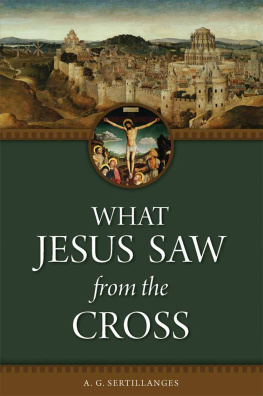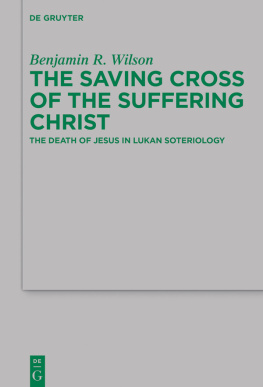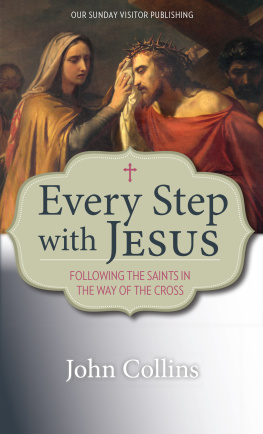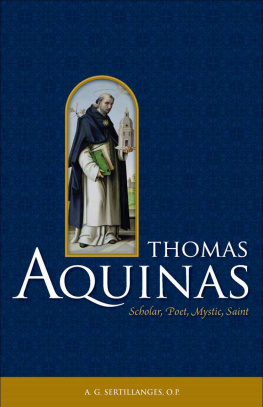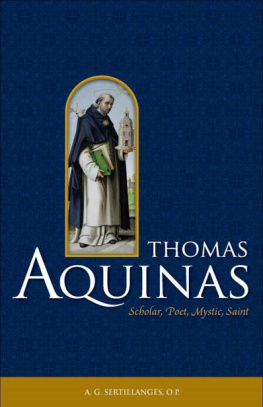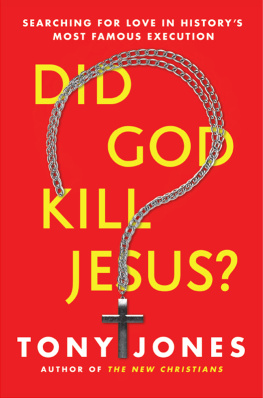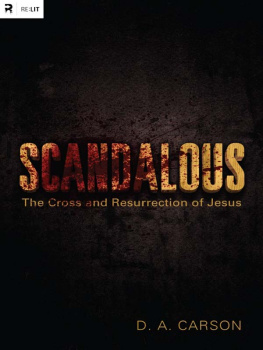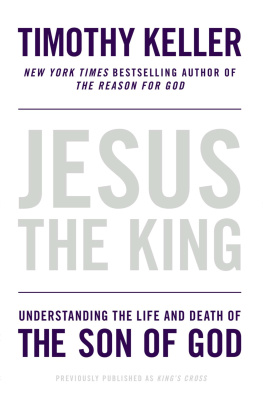A.G. Sertillanges - What Jesus Saw from the Cross
Here you can read online A.G. Sertillanges - What Jesus Saw from the Cross full text of the book (entire story) in english for free. Download pdf and epub, get meaning, cover and reviews about this ebook. year: 2013, publisher: Sophia Institute Press, genre: Detective and thriller. Description of the work, (preface) as well as reviews are available. Best literature library LitArk.com created for fans of good reading and offers a wide selection of genres:
Romance novel
Science fiction
Adventure
Detective
Science
History
Home and family
Prose
Art
Politics
Computer
Non-fiction
Religion
Business
Children
Humor
Choose a favorite category and find really read worthwhile books. Enjoy immersion in the world of imagination, feel the emotions of the characters or learn something new for yourself, make an fascinating discovery.
- Book:What Jesus Saw from the Cross
- Author:
- Publisher:Sophia Institute Press
- Genre:
- Year:2013
- Rating:5 / 5
- Favourites:Add to favourites
- Your mark:
- 100
- 1
- 2
- 3
- 4
- 5
What Jesus Saw from the Cross: summary, description and annotation
We offer to read an annotation, description, summary or preface (depends on what the author of the book "What Jesus Saw from the Cross" wrote himself). If you haven't found the necessary information about the book — write in the comments, we will try to find it.
What Jesus Saw from the Cross — read online for free the complete book (whole text) full work
Below is the text of the book, divided by pages. System saving the place of the last page read, allows you to conveniently read the book "What Jesus Saw from the Cross" online for free, without having to search again every time where you left off. Put a bookmark, and you can go to the page where you finished reading at any time.
Font size:
Interval:
Bookmark:
What Jesus Saw from the Cross
A. G. Sertillanges
SOPHIA INSTITUTE PRESS
Manchester, New Hampshire
What Jesus Saw from the Cross was published in French as Ce que Jsus voyait du haut de la croix by Ernest Flammarion of Paris in 1930. An English translation was published originally by Clonmore & Reynolds Ltd. in Dublin in 1948. This 1996 edition is based on the 1948 translation but has been edited to conform it to standard modern English usage and to correct other infelicities in the text. Explanatory footnotes have been added throughout.
Copyright 1996 Sophia Institute Press
Printed in the United States of America
All rights reserved
Jacket design by Carolyn McKinney
On the cover: Crucifixion (Jerusalem with temple and turreted walls), contemporary copy of a lost painting by van Eyck (c. 1530) / Museum of Fine Arts, Budapest, Hungary / Lessing Photo Archive.
Circular detail: Crucifixion (oil on panel), Brea, Ludovico (c.1450-1523) / Church of Cimiez, Nice, France / Giraudon / The Bridgeman Art Library International.
No part of this book may be reproduced, stored in a retrieval system, or transmitted in any form, or by any means, electronic, mechanical, photocopying, or otherwise, without the prior written permission of the publisher, except by a reviewer, who may quote brief passages in a review.
Sophia Institute Press
Box 5284, Manchester, NH 03108
1-800-888-9344
www.SophiaInstitute.com
Sophia Institute Press is a registered trademark of Sophia Institute.
Nihil obstat:
Ernest Messenger, Censor deputatus
Imprimatur:
Joseph Butt, Vicar General,
Westmonasterii, January 8, 1937
p. cm.Originally published: Dublin : Clonmore & Reynolds Ltd., 1948.
Includes bibliographical references.
ISBN 0-918477-25-5 (hdbk.)ISBN 0-918477-37-9 (pbk.) 1. Jesus ChristCrucifixion. I. Title.BT450.S4213 1996
232.963dc2094-42378 CIP
Editors Note: The biblical references in these pages are based on the Douay-Rheims edition of the Old and New Testaments. Where appropriate, quotations from the Psalms and some of the historical books of the Bible have been cross-referenced with the differing names and enumeration in the Revised Standard Version using the following symbol: (RSV=).
Prologue
St. Paul exhorts us to put on Jesus Christ, and his words, understood in the spiritual sense in which he intended them, are of immeasurable importance. However, there is perhaps another sense in which it is not impossible, nor without importance, to put on Jesus Christ.
We may put on Jesus Christ in imagination, placing ourselves not at the foot of the Cross, nor before it, but upon it, with head bowed beneath the inscription, wearing the crown of thorns, pierced by the nails, feeling the cold, rough wood between our shoulders. In short, we can make our own the sphere of vision and the emotions that were His, seeing with His eyes and feeling with His heart, remembering, judging, and foreseeing with Him so that, still in this same sense of imagining that we have changed places with Him, it is no longer we who live but Christ who lives in us.
It was in Jerusalem that this thought came to me, while I stood (as I frequently did) on a spot which is uniquely suggestive of such reflections.
On the terrace of the Greeks overlooking the atrium of the Holy Sepulcher, a few paces from the great dome, is a small stone cupola surmounted by a cross. It can be reached quite easily, and you may stand there and linger. If you now face Jerusalem, which is spread before your eyes, making allowances for the changes operated by time, you are confronted with the same panorama as met the gaze of the divine Master.
According to the most careful calculations and on the authority of one who knows the archaeology of the Holy Land better than anyone of the present day, the iron cross which you are touching there marks, within a few inches, the level and the place once occupied by the divine countenance. A striking thought, which recalls the words of St. Cyril of Jerusalem as he preached at the Holy Sepulcher: How many others are able only to hear, while we can see and touch!
The scene of the crucifixion is today changed beyond recognition; the mere mention of my observation post would be sufficient to show this. But it is possible to reconstruct it without any great difficulty. A few doubtful points remain to be settled, and torturing those doubts are for it is not easy to reconcile ourselves to the regrettable fact that we cannot at this moment with certainty trace out the Way of the Cross. But the remainder of the sacred site is happily known to us. Its general lines are indicated for us by the hills that encircle Golgotha. The knolls, the valleys, partly filled but plainly discernible, still remain; the roads are determined by the formation of the ground and by immutable directions. The ruins visible here and there, the excavations made in recent times, the comparative study of texts and of facts enable us to recognize and even to establish with precision the theater of the drama. We may feel the thrill of reality.
Let us, then, without further delay open our eyes, the eyes of our body and the eyes of our intelligence, with Jesus Christ. As we put on Jesus Christ let us wed ourselves to His mind and His heart. So it may be that the invisible world in which His soul moves will appear more vividly to us, and perhaps we may be granted the grace of a more intimate union with Him.
A. G. Sertillanges
Jerusalem Holy Thursday Evening
The View from the Cross
When Jesus leaves the praetorium, it is about twelve oclock, in Jerusalem the sultriest hour of the day.
It is springtime March 20th at the earliest, April 17th at the latest but spring in the Holy Land has none of the charm of our April. Spring is the season of uncertain weather; one day will be beautiful, the next may bring snow or stifling heat. It is the season of the Khamsin, the hot, depressing wind that comes from the southwest.
Jesus is carrying His Cross. To His neck, probably, is attached the placard two feet square, whitened with chalk, which will be nailed to the Cross to advertise the nature of His crime. He is preceded by a mounted centurion and escorted by a band of soldiers. For company Jesus has two thieves whom they have decided to execute with Him. In front, behind, and around Him is an inquisitive or hostile mob.
For some two hundred yards in a direct line, but rather more through the network of narrow streets, their way lies downhill through the town. Then the road slopes upwards, always winding, bringing the total distance to five hundred yards. The procession thus reaches the Gate of Ephraim, otherwise called the Gate of the Square because it opens upon a square esplanade, bounded by a right-angled corner in the walls. This was later to become the Roman forum.
The Gate of Ephraim is a redan gate. That is, it forms a salient angle [pointing outward instead of inward], so that the entrance is from north to south and the exit from east to west. It is interesting to recall that in a Greek convent nearby, an ancient step is preserved upon which Jesus may have trod as He carried His Cross.
Immediately after He crossed the threshold, Jesus stood faceto-face with His tomb.
There was nothing gloomy about the prospect, in spite of the tombs, which were a common feature of the wealthy properties of the period. The gate between that of Ephraim and that of Jaffa was called the Gate of Gardens; and in fact all the slopes of Gareb, the hill opposite, were under cultivation.
Olives formed the chief part of the vegetation, but there were also citrons, figs, nuts, and pomegranates. Many birds made their nests in the branches of these trees, swallows and martins making merry in the springtime, along with sparrows, lapwings, cuckoos, thrushes, and turtledoves. Nor was there any lack of flowers. The place was carpeted with cyclamens, the flower of rocky ground, wild daffodils, irises, fennel, poppies, and daisies, and especially the red anemone. Perhaps, too, there was the lily of the field that vies with the glory of Solomon a flower which glitters like a stained-glass window when the sun shines upon it, but in the shade has the dull hue of dried blood.
Next pageFont size:
Interval:
Bookmark:
Similar books «What Jesus Saw from the Cross»
Look at similar books to What Jesus Saw from the Cross. We have selected literature similar in name and meaning in the hope of providing readers with more options to find new, interesting, not yet read works.
Discussion, reviews of the book What Jesus Saw from the Cross and just readers' own opinions. Leave your comments, write what you think about the work, its meaning or the main characters. Specify what exactly you liked and what you didn't like, and why you think so.

